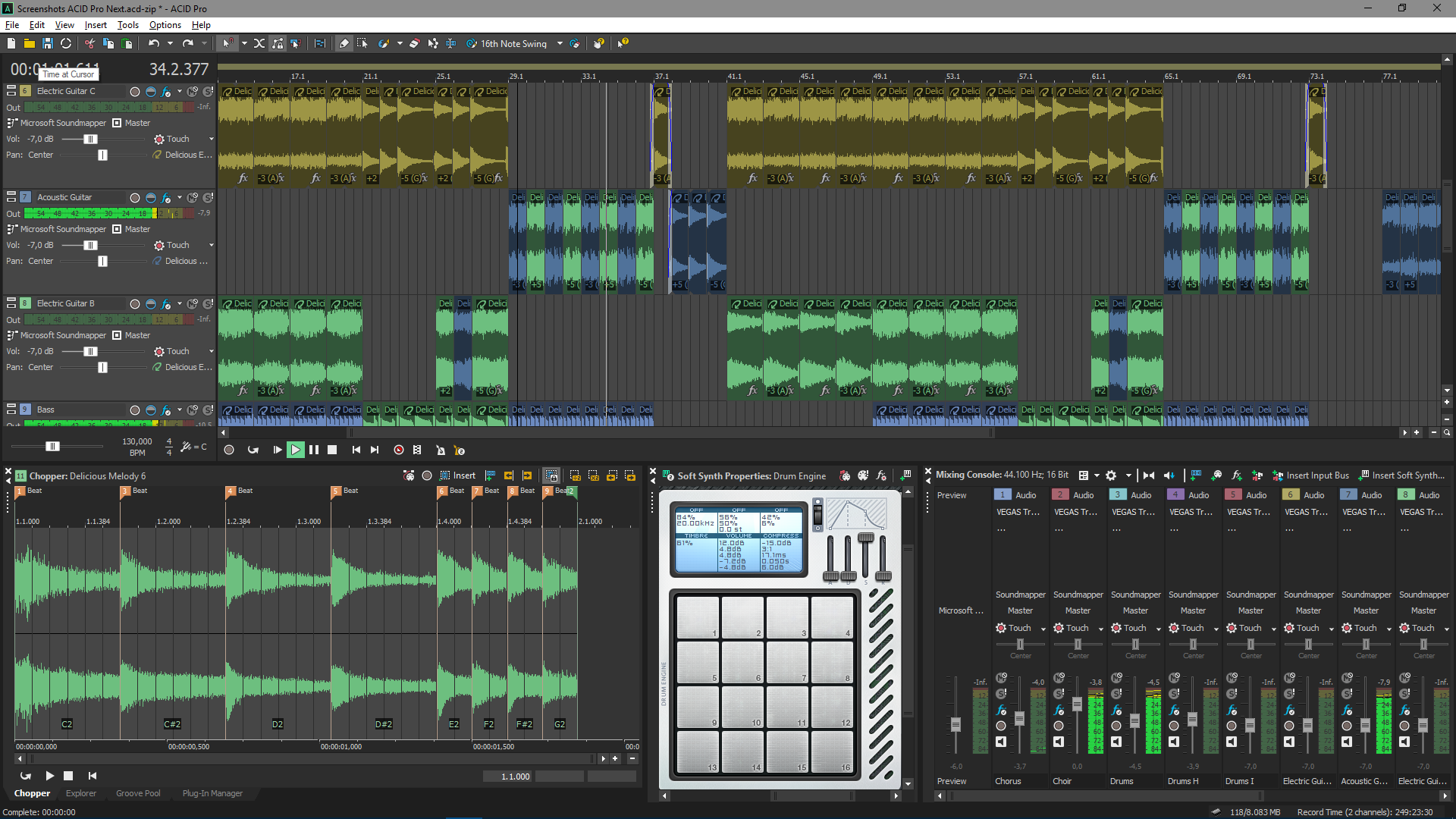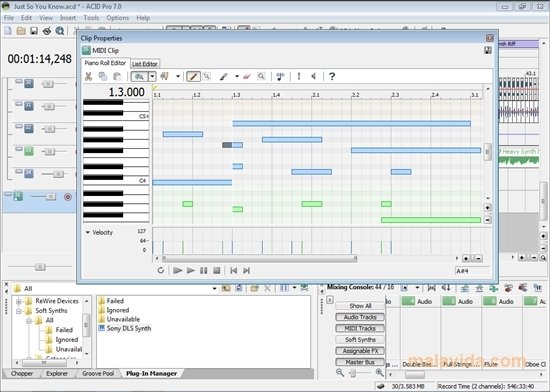Acid Pro 8 also bundles Magix’s long‑serving Vandal guitar rig simulator, which includes amplifier modelling, cabinet simulation with a decent selection of cabinet types and options for blending two different microphone models, a handful of overdrive and modulation stompbox models and two slots for post‑amp effects that provide reverb. ACID Pro 7 is a DAW powerhouse that combines full multitrack recording and mixing, MIDI sequencing, and our legendary ACID looping functionality for a seamless music-creation and post-production environment. Last update 29 Jan. 2013 Licence Free to try $184.95 OS Support Windows XP, Windows Vista, Windows 7, Windows 8 Downloads. MAGIX ACID Pro Key Features: Meet your new creative partner in crime. ACID Pro 8 is a powerful 64-bit DAW that has ACID’s famous innovative audio looping, powerful multitrack recording and hi-end audio and MIDI features, all set within an easy-to-use interface to help artists of all levels create their dreams. Sony Creative Software inspires artistic expression with its award-winning line of products for digital video production. The Catalyst Production Suite fuses powerful media preparation and fast, focused video editing to provide the backbone for your video productions.
Sony Acid Pro 8 Full - Keygen Download
Increase your latency settings
From the Options menu, choose Preferences. The Preferences dialog is displayed.
Select the Audio Device tab and click the Advanced button. The Advanced Audio Configuration dialog is displayed.
Select the ASIO driver tab and click the Configure button to display the configuration applet from your hardware manufacturer.
Type a new latency value, apply the change, and close the configuration applet to return to the Advanced Audio Configuration dialog.
Click the Apply button in the Advanced Audio Configuration dialog.
Turn off other audio devices
You can only use a single ASIO driver at a time, and some ASIO drivers can conflict with other audio driver models (such as WDM and wave drivers).
Getting your computer to play back a complex project can be a bit like walking a tightrope: there’s a delicate balance between responsive playback and glitch-free playback. The trick is finding the sweet spot for your hardware.
For more information about setting advanced audio preferences, click here.
From the Options menu, choose Preferences, and then click the Audio Device tab.
Click the Advanced button to display the Advanced Audio Configuration dialog for your sound card.
Adjust your buffer size until playback is responsive and clear.
For wave devices, try raising and lowering from the default settings until you find the sweet spot. Use the Buffer size drop-down list to choose a buffer size in samples, or choose MME to use the Playback buffering setting on the Audio Device tab in the Preferences dialog. You can also try increasing the Audio buffers setting to increase the number of buffers created. As a last resort, choose Time Critical from the Priority drop-down list.
For ASIO devices, start with a setting of 2048 samples. If playback is glitch free, you can try decreasing the setting. If you hear glitches, you may need to raise the setting.
Higher sample rates (and bit depths) may require a larger buffer because more data is being put through your device per buffer.
Turn on real-time MIDI monitoring
If you have a MIDI track routed to an external MIDI device, real-time MIDI monitoring must be enabled to allow ACID software to communicate with the MIDI port.
Real-time MIDI monitoring is enabled by default, but if you’ve turned it off, you can turn it on again by choosing Enable Real-Time MIDI from the Options menu.
When the Enable Real-Time MIDI command is selected, audio plug-ins continue running even when playback is stopped. Turning the command off can conserve processing power, but input from external MIDI controllers will be ignored.

Enable the VST instrument
If you’re using a VST instrument, select the Enable button in the Soft Synth Properties window to hear its output.
Try a different soft synth
Unfortunately, some soft synths work better than others. Try routing your soft synth to a different DLS set or VST instrument.
ASIO sound drivers can cause conflicts with the Microsoft GS Wavetable Synth. To play your project, choose a different device for MIDI playback and verify that no other application is trying to use non-ASIO drivers.
Unfortunately, there is no standard way for a DirectX host application to determine whether a plug-in is automatable. For this reason, the application does not check a plug-in until you try to use it (just think of the time we’re saving you at startup).
After you use a plug-in, the application can determine whether it is automatable and it will appear in the correct folder in the Plug-In Chooser and will be indicated by the icon if it is automatable.
Adjusting these settings can resolve issues with some specific VSTi plug-ins. These settings will vary with your specific configuration and can be modified via the Windows Registry.
Incorrectly modifying the registry can degrade performance or cause serious problems with your operating system. If you’re uncertain how to change these settings, please use the defaults.
Sony Acid Pro 8 Serial Number
Start the Windows Registry Editor.
Browse to the key [HKEY_CURRENT_USERSoftwareSony Creative SoftwareACID Pro7.0MetricsVSTi Synth].
Edit the appropriate DWORD value:
DWORD
Default Value
Explanation
FlushOnStopCount
00000000
Some VST instruments (such as FruityLoops) do not flush their buffers on close and will output these buffers the next time you play or render your project. Entering a value in theFlushOnStopCountDWORD allows you to flush up to 500 buffers of audio.
FrameSize
00000006
Frame size defaults to 6 ms, but can be set as high as 2000 ms. This should rarely need to be modified.
Both of these settings apply to playback, seeking, and rendering. Excessively high values can cause latency that can appear as an application crash. For example, if you set your buffer size to 2000 ms and set ACID software to flush 500 buffers, you’ll create a 1000 second hang on every stop, seek, or render.
If you have a MIDI port configured in both ACID software and a ReWire client application, they will conflict when both applications try to access them at the same time.
If you want to use the MIDI port to play synths within a ReWire client, clear the port’s check box in the Make these devices available for MIDI track playback and Generate MIDI clock section of MIDI tab in the Preferences dialog.
If you want to use your MIDI port in ACID software, make sure your ReWire client is not configured to use the port.
We’re here for you. . . really. This topic is meant to help you get over those annoying little hurdles that are keeping you from doing what you really want to do: get back to creating some great music with ACID software.
What’s not working for you?
The audio from my ASIO sound card keeps dropping out. What gives?
My audio skips and gaps when I play my project. Can I fix it?
Why can’t I hear the output of my MIDI controller through the soft synth or MIDI thru port?
When I try to play my project, the ACID application tells me that it can’t open the Microsoft GS Wavetable Synth. Whatever can I do?
Why don’t all my automatable plug-ins appear in the Automatable folder?
I want to adjust the buffer size and buffer flushing for my VSTi plug-ins, but I can’t find a setting in the Preferences dialog.
When I try to play my project, I see an error message that tells me a MIDI port is currently in use. What should I do?
Troubleshooting
| Developer(s) | Sony Creative Software, Magix Software (2016), Sonic Foundry (1998) |
|---|---|
| Stable release | |
| Operating system | Windows 8.1 or later |
| Type | Digital audio workstation |
| License | Proprietary |
| Website | https://www.magix.com/us/music/acid/ |
Acid Pro (often stylized ACID) is a professional digital audio workstation (DAW) software program currently developed by Magix Software. It was originally called Acid pH1 and published by Sonic Foundry, later by Sony Creative Software as Acid Pro, and since spring 2018 by Magix as both Acid Pro and a simplified version, Acid Music Studio. Acid Pro 8 (the current version as of 2019) supports 32-bit and 64-bit architectures, and has MIDI, ASIO, VST, VST3, DirectX Audio, and 5.1 surround sound support.

Sony Acid Pro 8
History[edit]
Acid was first launched in 1998, as Acid pH1, by Sonic Foundry in Madison, Wisconsin. It was a loop-based music sequencer, in which Acid Loop files could be simply drag-and-dropped then automatically adjust to the tempo and key of a song with virtually no sonic degradation.

A website for budding musicians using Acid technology was set up, named AcidPlanet.com. The software became very popular in the late 1990s and early 2000s among composers, producers, and DJs interested in quickly creating beats, music textures, or complete compositions and orchestrations, that would work with virtually any tempo or key signature.
Sonic Foundry sold its Acid, Vegas, Sound Forge, CD Architect, Siren, VideoFactory, ScreenBlast, and Batch Converter product lines to Sony Pictures Digital in July 2003; the merger resulted in the new Sony Creative Software division.[1] Sony's Acid Pro 6 (released in the third quarter of 2006) introduced a full-digital audio workstation that also included MIDI and multitrack audio recording with full support for ASIO computer-audio and VST synthesizer-plugin standards.
On May 20, 2016, German company Magix Software GmbH announced they had acquired the majority of the products in the Sony Creative Software portfolio. These include Acid Pro, Vegas Pro, Movie Studio, and Sound Forge Pro.[2] Acid Pro 8, the first version since Magix's acquisition, was announced on January 21, 2018 and released in spring 2018. The update came with new modern features including an enhanced interface, support for 64-bit, additional samples, VST3 support, over 20 DirectX audio effects, the ability to mix in 5.1 surround sound, and new features named Media Manager, BeatMapper, and Chopper.
In one version or another, Acid Pro runs on PCs with all versions of Microsoft Windows since Windows 2000; Acid Pro 8 requires Windows 8.1 or later. Versions do not exist for macOS or Linux.
Acid Loops[edit]
Acid Loop (trademark), also Acidized or Acidified loop (generic terms), refers to a sound clip which can be repeated and transposed to form a song with minimal manual adjustment. Acidized loops contain tempo and key information, so that Acid can properly time-stretch and pitch-shift the clip to fit into an existing track structure. An Acidized loop is a specially prepared WAV audio file, which can be created using an audio-editing tool such as Sound Forge.

The technology was created in 1998 for Sonic Foundry's original Acid pH1 software. Sony and Magix later sold series of Acidized loop sample CDs to be used with Acid Pro, as have various third-party companies. Since then, this looping technique has been adopted by the majority of other digital audio workstations on the market, sometimes with competing brand names for the feature, such as Cakewalk Sonar (calling it Groove Clips), and Cubase (calling it Audio Warp). Many DAWs can also directly support Acidized loops intended for use in Acid Pro.
Other versions[edit]
- Acid Music Studio is a simplified, lower-cost version of Acid Pro. The latest version as of 2019 is Acid Music Studio 11.[3]
Acid Pro 7
See also[edit]
Sony Acid Pro 8 Keygen Free Download
References[edit]
- ^Marc Ferranti, IDG News Service (May 3, 2003). 'Sony Buys Sonic Foundry Products'. pcworld.com. Archived from the original on January 26, 2009. Retrieved December 17, 2009.
- ^LaJeunesse, Nicole (May 24, 2016). 'MAGIX Acquires Sony's Vegas Pro Plus Majority of Sony Creative Software Offerings'.
- ^'ACID Music Studio 11: Kick-start your music production'. www.magix.com.